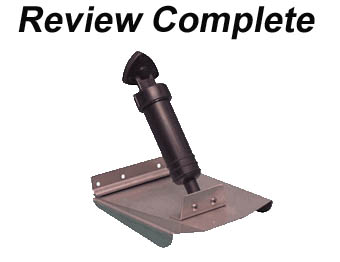
Bennett Trim Tabs
Rating: Not Rated YetQuick overview
- Bennett Trim Tabs fully automated.
- Electronic Indicator Control.
- Auto tab retractor.
- Auto tab control.
Over the years boat hull designers have stepped up to the plate and started creating designs that handle better, are stronger, faster, make less noise, and so on. On the other side, trim tab manufacturers have had the challenge of keeping up with and even surpassing hull designers to complement an already good design, and that's exactly what Bennett has done with their latest line of trim tabs and accessories.
 Bennett has substantially raised the technology bar with its latest and greatest Auto Tab Control, or ATC; a system that is unmistakably engineered by Bennett Marine. Designed to incorporate seamlessly with an existing Bennett system, the ATC is the trim tab system for "Dummies." Well, not exactly, but the intelligent CPU takes all the guesswork out of tab control and leaves the captain virtually hands free to navigate.
Bennett has substantially raised the technology bar with its latest and greatest Auto Tab Control, or ATC; a system that is unmistakably engineered by Bennett Marine. Designed to incorporate seamlessly with an existing Bennett system, the ATC is the trim tab system for "Dummies." Well, not exactly, but the intelligent CPU takes all the guesswork out of tab control and leaves the captain virtually hands free to navigate.
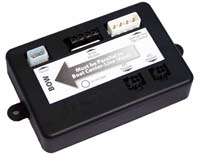 The ATC Control Unit acts as both a sophisticated processor and attitude sensor. Once programmed, which is achieved by simply running the boat in the trim position that you feel is optimum and then pressing a button to set the memory, the ATC then "remembers" that setting and automatically keeps the boat running at the desired attitude by self adjusting each tab. The Control Unit calculates and analyzes attitude readings more than a thousand times per second. It averages the readings and is programmed not to react to every wave This allows the systems to react to more long-term movements, such as those caused by load shifting or an already unbalanced load.
The ATC Control Unit acts as both a sophisticated processor and attitude sensor. Once programmed, which is achieved by simply running the boat in the trim position that you feel is optimum and then pressing a button to set the memory, the ATC then "remembers" that setting and automatically keeps the boat running at the desired attitude by self adjusting each tab. The Control Unit calculates and analyzes attitude readings more than a thousand times per second. It averages the readings and is programmed not to react to every wave This allows the systems to react to more long-term movements, such as those caused by load shifting or an already unbalanced load.
The ATC can be easily switched to manual control via its own operating keypad (shown in fig 1), which allows you to turn it on or off at the push of a button, or simply by pushing one of the manual tab switches. This ensures that you have instant tab response in case you need it in a hurry.
While an automated system such as the ATC is a breakthrough in the industry, it certainly wouldn't be complete without the end product, a set of high quality well engineered tabs to take advantage of this technology.
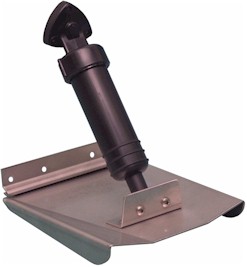 The M120 series batwing tabs fit the bill perfectly. Bennett really did the traditional flat tab system justice with the downward folding wings and a unique center bevel that amazingly grips the water with authority. The wings provide superb stability and channel the water in a manner that provides greater lift. Not only do the M120's provide increased lift and stability, they also take up much less space.
The M120 series batwing tabs fit the bill perfectly. Bennett really did the traditional flat tab system justice with the downward folding wings and a unique center bevel that amazingly grips the water with authority. The wings provide superb stability and channel the water in a manner that provides greater lift. Not only do the M120's provide increased lift and stability, they also take up much less space.
Install & Sea Trial
SYSTEM: M120 Batwing tabs / Auto Tab Control / Electronic indicator Control / Auto Tab Retractor
NOTE: Due to the complexity of this system, and the need for long term durability testing, this review will be in 2 parts. Part 1 will cover the install, functions and test ride of the system, and part 2 will cover the durability of the components.
I don't know about you, but me, I'm a gadget guy. As so, it takes a lot to get me excited. When I found out that Bennett came to market with this system I had to have it. Did I also mention that I love automation! Needless to say, this system was right up my wake and calling my name!.
Upon deciding to go with Bennett, which was just a matter of me googling their phone number, I spoke to them several times on the phone, not trying to figure out what components that I wanted, as I already decided on a complete system, but rather trying to figure out what size tabs I wanted. My 20 foot Hewes originally came with 12x12 flat tabs, so obviously I wanted no less than 12x12 tabs because I wasn't getting the kind of lift that I wanted, and ignoring their suggestions at first, I insisted on stepping up to bigger tabs. I thought for sure that bigger tabs meant bigger lift and better control. Finally, I went with the tabs that they recommended, which were actually several inches smaller and made me a bit skeptical.
The day it arrived I saw the box as I pulled into my drive. Anxious to see the goodies, I quickly snatched up the box and ran inside ignoring my beast of a German shepherd. As I ripped at the box with my keys, my dog was just as excited, apparent by his willingness to peel off the tape and sniff the box to ensure my safety! At first glance I got the giggles and removed each piece, laying them neatly to the side. The package protection was ample and each piece secured soundly inside.
 The pump system looked fantastic, well designed, heavy duty and sort of a showpiece if you are into quality as I am. I also dabble in track cars and engine mods so quality parts are irresistible to me. I did notice one thing that concerned me which was the use of a rubber boot style connector, which is not bad for protection, but in my opinion not nearly as good in quality and durability as an IP (Ingress Protection Rating) rated Deutsch connector, but time will tell.
The pump system looked fantastic, well designed, heavy duty and sort of a showpiece if you are into quality as I am. I also dabble in track cars and engine mods so quality parts are irresistible to me. I did notice one thing that concerned me which was the use of a rubber boot style connector, which is not bad for protection, but in my opinion not nearly as good in quality and durability as an IP (Ingress Protection Rating) rated Deutsch connector, but time will tell.
COMPONENT UPDATE: After 2 years of use, perhaps 25 trips, the port solenoid failed. I know Bennett makes good pumps, and the failure on this is more than likely due to pulling in some saltwater after the port tab was pulled from the transom. The Hewes is a no-wood transom, and the screws that came with the tabs certainly did not appear large enough, nor long enough. I did question Bennett and they said it would be ok. I went against my gut and lost a tab in a heavy storm. My fault for not following my initial gut feeling. I did install larger screws and shot some epoxy into the holes this time around. Overall the pump performed as expected with no issues.
 Next I removed the trim tabs and noticed instantly the one piece design with no welds to break or rust, a very nice weight indicating quality, and soft edges to eliminate line cut offs. Nice touch! The actuators were very lightweight, and all the hardware felt very sturdy. To say the least, I was impressed and couldn't wait to get these awesome looking tabs on my boat. Another thing I noticed here was the two 2 pin port and starboard wire connectors from the actuators (green & red) which contained very thin pins that plug into the control module. Unfortunately, there isn't any quality way of sealing these since they plug into the module, and sit inside the module connection which I anticipate may be an issue (see EIC relay module below). Again, I would have rather seen the use of a better IP rated connector, as well as a different connector, but time will tell. I do see some reasoning why the connections are so small here, as they must pass through a small hole in the transom, but other options could have been explored.
Next I removed the trim tabs and noticed instantly the one piece design with no welds to break or rust, a very nice weight indicating quality, and soft edges to eliminate line cut offs. Nice touch! The actuators were very lightweight, and all the hardware felt very sturdy. To say the least, I was impressed and couldn't wait to get these awesome looking tabs on my boat. Another thing I noticed here was the two 2 pin port and starboard wire connectors from the actuators (green & red) which contained very thin pins that plug into the control module. Unfortunately, there isn't any quality way of sealing these since they plug into the module, and sit inside the module connection which I anticipate may be an issue (see EIC relay module below). Again, I would have rather seen the use of a better IP rated connector, as well as a different connector, but time will tell. I do see some reasoning why the connections are so small here, as they must pass through a small hole in the transom, but other options could have been explored.
COMPONENT UPDATE: These tabs are phenomenal when it comes to control. they grip the water and make your boat handle like never before. They are well made and after 4 years showed no signs of rust or staining. The actuators held up with no performance issues, but the sun did bleach them white within 6-8 months, so keep them covered, or perhaps put a UV blocker on them. The connections are another story, as you'll see below.
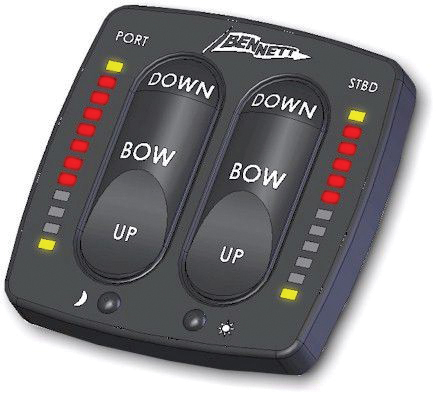 Next I pulled out all the control units from their protective packaging and admired the control pads. The soft touch rubber coatings and epoxy sealed backs were nothing short of a show piece that would soon blend in nicely next to my custom DSS keypads. Running both port and starboard on the pad are a series of LED position indicators, yet another great touch of styling and a very useful feature.
Next I pulled out all the control units from their protective packaging and admired the control pads. The soft touch rubber coatings and epoxy sealed backs were nothing short of a show piece that would soon blend in nicely next to my custom DSS keypads. Running both port and starboard on the pad are a series of LED position indicators, yet another great touch of styling and a very useful feature.
COMPONENT UPDATE: I Had to replace this piece and the ATC tab control, as both dry-rotted in less than two years. The switch worked well, but often needed programmed for no apparent reason. Programming is just a matter of holding down the keys for a few seconds until it flashes, and then running the tabs up and down. They worked after that, but multiple times per trip became a bit of an annoyance. Overall, I'd say figure out how to keep them from dry-rotting and they are pretty good controls that certainly let you know the attitude of the boat at a glance.
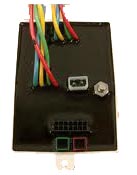
COMPONENT UPDATE: I could not keep this unit working more than 6 months, despite being mounted in a cubby hole where no water could make direct contact. However, I believe condensation formed, and, as stated above, seeped onto the connections. I constantly found the connection pins corroding, even with protection gel. The ground post nut rusted and seized to the terminal post, thus I had to order a new unit, as the terminal spun when trying to free the nut. Every connection that is potted into the unit corroded on both units. After speaking with Bennett they said I needed to mount all the hardware under the center console, as the could not handle any moisture. As much as I like Bennett, come on now, this is a marine product. I have other products mounted in the same area, from battery ratchet straps, fuse holders, relays, battery switch, LED driver unit, etc, and they were not corroding. The area was free from direct water contact, was high and dry, but being in the hull had some moisture. I had some WalMart ratchet straps in there over 2 years that didn't lock up. The issue is the thin metal of the pins not being able to handle any moisture whatsoever, in addition to the plug configuration and IP rating as mentioned above.
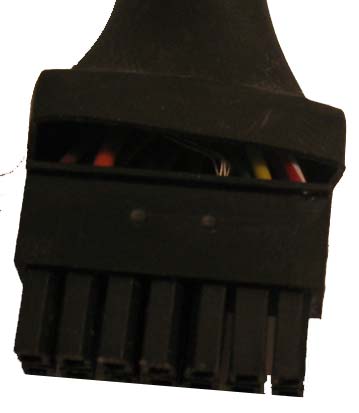 This is the connector from the main cable running from the EIC control to the EIC relay module. It is a 14 pin male casing with female inserts that seats flush to the male pins on the module. As shown to the left, the first thing I noticed was that the heat shrink comes loose around the connector just by simply bending the wire a bit. After inspection, a gentle tug reveals the wires inside and a straight open air connection to the modules pins for any moisture to find its way to. This is a very poor marine connector and I suspect this plug to cause issues. Also, you'll need to make sure to put a tension loop in this wire and secure it firmly. The tolerance of this connection and its counterpart is nil, so when running this wire through your passages be sure to tape the ends to pad them or you'll find any nick will make it not fit. This applies to the EIC control end as well. Though this connector locks in place once seated, a little wiggle on the cable reveals a gap between the two connections that may let moisture in. Time will tell.
This is the connector from the main cable running from the EIC control to the EIC relay module. It is a 14 pin male casing with female inserts that seats flush to the male pins on the module. As shown to the left, the first thing I noticed was that the heat shrink comes loose around the connector just by simply bending the wire a bit. After inspection, a gentle tug reveals the wires inside and a straight open air connection to the modules pins for any moisture to find its way to. This is a very poor marine connector and I suspect this plug to cause issues. Also, you'll need to make sure to put a tension loop in this wire and secure it firmly. The tolerance of this connection and its counterpart is nil, so when running this wire through your passages be sure to tape the ends to pad them or you'll find any nick will make it not fit. This applies to the EIC control end as well. Though this connector locks in place once seated, a little wiggle on the cable reveals a gap between the two connections that may let moisture in. Time will tell.
COMPONENT UPDATE: This plug corroded, worked its way loose, and constantly had issues maintaining connections. This plug should have been a female casing that slid over a male potted plug, and latched securely to keep it tight and sealed.
Now that you got the jest of my mentality when it comes to new products, let's move on to the sea trial portion of this article. Keep in mind that even though I had a trim tab system previously, I did remove the old system entirely, and even had the through holes in the transom filled several weeks earlier when I had the boat restored.
The install was straight forward and very easy, as all the components are virtually plug-and-play, and only a few holes need to be drilled through the transom for the hydraulic tubing. Additionally, a few leads and grounds need to be ran along with the cables to connect each component. It's painless and shouldn't take more than a few hours depending on your boat and access to wiring canals below your deck. Bennett's instructions are precise and laid out in a manner that is very easy to follow. In fact, I didn't even use the instructions, but I wouldn't recommend a novice


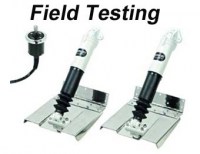 UFlex Trim tabs -- Initial Review
UFlex Trim tabs -- Initial Review